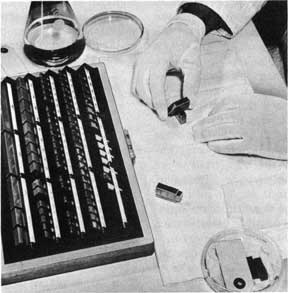Bal-tec™ Home Handle Those Gage Blocks with Care
Handle Those Gage Blocks with Care
How to Wring Gage Blocks
Today's close manufacturing tolerances require special care of inspection tools to maintain them in original precision condition. This article tells how a lapping job shop keeps gage blocks in top shape.

In a lapping service, many gage block setups are used each shift. To minimize error, we have developed a special system of gage block handling. The methods we used in solving the problems encountered in shop use of gage blocks are as follows:
Worn Blocks
Excessive gage block wear is caused mainly by dirt. Some is airborne; but most is carried to the gage blocks by the operator's hands. Constant washing of hands isn't the easiest way to eliminate this problem. Instead, wearing a pair of white nylon gloves, while wringing up a combination, helps much more. Airborne dirt may be minimized by keeping the gage block case closed when not in use. After being wrung, the gage combination should be placed in a covered petrie dish. Except for actual use, keep in this dish until returned to the set. To reduce use-wear, it pays to wring a chrome carbide wear block on both sides of every combination. These blocks should be wrung with the plain side of the wear block against the gage block face, that is, with the lettering on the outside. Thus all scratching and wear occurs on the face that will not mar other surfaces when being wrung.
Burred Blocks
Another common wear problem is caused by burrs. In wringing a combination, one block may slip over the edge of another or a block may be dropped. If this burred block is wrung up, it will scratch the other block. Since blocks are wrung in successive combinations the entire set can soon be ruined. To minimize this damage, any minor scuff or burr should be removed on a special black granite plate at the wringing station. Make sure that the block is first cleaned with mineral solvent so that it is dry. Then rub the burred side lightly on the black granite plate. Use a straight line motion parallel to the long axis of the block. Any dented block should be removed and replaced immediately.
Rust
Precautions already mentioned, such as wearing nylon gloves and keeping the case closed, will greatly reduce rust. In addition, never allow a gage block combination to remain wrung up more than one shift. We have found that blocks left wrung up rust very rapidly. Before returning the gage block combination to the case, the blocks should be cleaned with a fast-drying solvent and dried with lint-free cellulose tissue (Kimwipes Type 900 S). A rust preventive oil should then be applied with a piece of oil-tanned chamois.

Poorly Wrung Combinations
An uneven separation of blocks is caused from burrs, too heavy an oil film, or dust between blocks. On removal of blocks from the case, the rust preventive oil should be wiped off with a lint-free cellulose tissue. Solvent should not be used because a minute amount of oil aids wringing and reduces galling.
After a final visual check for lint, the surfaces should be pressed together lightly at right angles (Figure 1). If, at this point, the blocks slide easily, or fall apart, they should be cleaned again. If they still don't wring, then one of the blocks is probably burred and should be corrected as previously described. A poorly wrung gage combination is almost always out of parallel. As a final check, measure each combination for parallelism. When the wring is complete, the blocks will hug together so that a high force is required to slip them apart.
Errors in Selection
To eliminate errors in gage block selection, use a dual check system by permitting authorized shop personnel to wring up their own gage block combination. Since the inspection department makes a separate gage block setup, a check is assured when the first work piece is inspected. To establish a uniform code for gage selection and to allow maximum lead-up range on sensitive indicating gages, select a combination equal to the high limit when measuring an outside dimension, and a low limit for an inside dimension. Use the minimum number of blocks possible because each wring presents a possible error. The simplest rule to remember in selecting individual blocks to make up a given combination is to select a block to eliminate the right hand digit of the dimension first, then the next, and so on until the combination is complete. As an example, let us select the gage blocks to measure an outside dimension of 1.2459"-1.2457". Since this is an outside dimension, we would set the combinations to equal the 1.2459" dimension.
| Gage Block combination example |
|---|
| 0.1009 |
| 0.145 |
| 0.800 |
| 0.100 (wear) |
| 0.100 (wear) |
| 1.2459 |
To avoid mistaken identity of the completed combination, a small white tag should be filled out listing each block in the combination. The sum of this list gives the dimensional value of the blocks and acts as an additional check for mistakes in arithmetic. This tag is placed with the blocks in the petrie dish.
